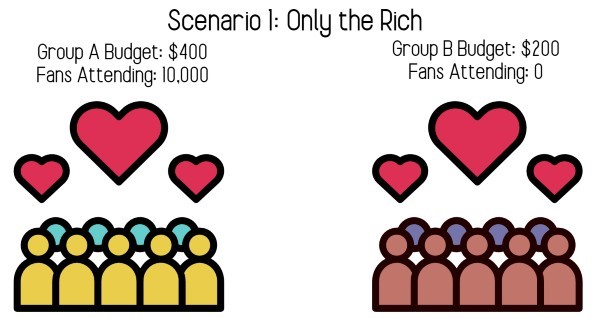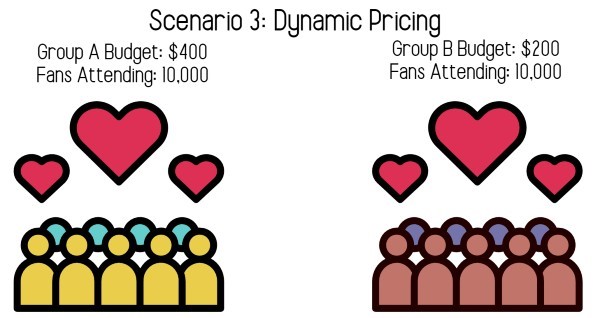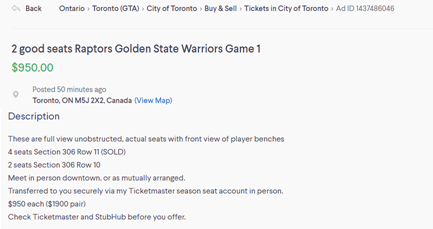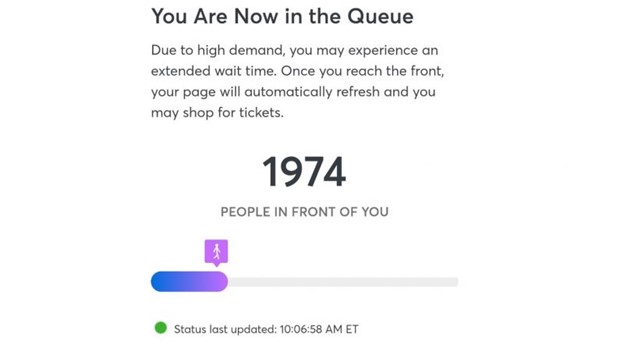Someone paid $76,477.50 CAD for a pair of tickets to Game 1 of the NBA Finals in Toronto. The average household income in Toronto is $65,929 CAD.
The average ticket price of NBA Finals games in Toronto is $1,933 CAD. With these unbelievable numbers, what’s a fan to do? Do you fork over a month’s worth of income to hopefully see your beloved basketball team fight tooth and nail for a championship? Or would that money be better put to use towards a nice 70′’ TV to watch the game with family and friends and still have enough left over for your child’s college fund (RIP OSAP)? I’m not going to tell you what to do with your money, but in this article I plan to break down the science behind ticket pricing.
Before I get into the ticket pricing and why it’s so hard to find affordable tickets, I need to explain what Dynamic Pricing is.
Dynamic Pricing = Changing the price for a product or service to reflect purchasing demand and access to the market.
This sort of pricing can be used anywhere, but has really made a significant impact in entertainment events. In contrast, the price of cereal probably won’t change like this, because availability outpaces demand.
A simple example of Dynamic Pricing
To better understand Dynamic Pricing, here’s a simple example. Imagine for a sporting event, say a Toronto Raptors playoff game, there are two groups of fans: a) willing to pay $400 per ticket to the game and b) willing to pay $200 per ticket for the game.
Each fan group consists of 10,000 people and the Scotiabank Arena where the game is being played has a capacity of 20,000 seats. Everyone has an equal opportunity of purchasing tickets. MLSE (the owners of the Toronto Raptors) would like the most diverse group of fans attending, yet still would like to make the most profit from ticket sales and eliminate the possibility of scalpers scooping up cheap tickets to resale at a much higher value.

Scenario 1 (Only the Rich): MLSE sells tickets for $400 per ticket. They will sell out 50% of the arena and the only people in the stadium will be the richer fans who were willing to pay more money.
Total Revenue: $4M ($400 * 10,000 seats)

Scenario 2 (Scalpers Paradise): MLSE sells tickets for $200 per ticket. Since there is an equal opportunity for all fans to get tickets, the first people on the waitlist from both groups will be able to purchase tickets.
However, you run into the issue of fans from Group A, noticing that they can purchase 2 tickets for $400 (still within their budget), will take that opportunity and purchase twice as many tickets. They will then resell their extra tickets to others in Group A who couldn’t wake up early enough to join the waitlist.
Total Revenue: $4M (Group A: 6,666 people bought 13,333 tickets at $200 + Group B: 6,667 people bought 6,667 tickets at $200)
Group A then sold 3,334 tickets for $400 each on the secondary market and MLSE will have lost out on ~$1.33M of potential revenue. This would meet the total demand of 10,000 for Group A (6,666 primary buyers + 3,334 resale buyers). The remaining 3,333 tickets bought by Group A will be resold at cost ($200) to people in Group B.

Scenario 3 (Dynamic Pricing): MLSE releases only half the seats in the stadium for sale at $400. The fans willing to pay this price point, will buy their tickets and will usually have an incentive to purchase first (like having seats closer to the court). MLSE will then release more tickets at a tiered system for $200. Group B will snag these tickets since the demand from Group A will have diminished from the first sale.
Total Revenue: $6M ($400 * 10,000 seats for people in Group A purchased 1 ticket each in the first release + $200 * 10,000 seats for people in Group B who purchased 1 ticket each in the second release)
There is little opportunity for scalpers to capitalize in this scenario.
Now take this example and apply it to an endless distribution of budgets with different populations of demand (something that is not very easy to anticipate) and you can see how ticket pricing can become a huge analytical nightmare. Not to mention different sections/rows are priced differently.
How MLSE used Dynamic Pricing to sell Tickets

I had an opportunity to view the tiered ticket release for the NBA Finals games on Monday May 29th, 2019. There were 4 release times (10am, 1pm, 3pm, and 6pm). The first two release times were for season seat holders, the third time was for insiders and season seat holders, and the final time was for everyone including the general public. Season seat holders were only allowed to purchase up to 8 tickets and each purchase of tickets they bought would send them to the back of the line.

Because tickets were far and few in between, I decided to look at upper bowl seats between rows 7-14 in the corners of the arena. It should be noted, that different games would have different price points. For example, Game 7 will sell at a premium because it is an elimination game. The highlighted sections above are tickets that were found throughout the day. Hypothetically, they should have a similar price. The price for these types of seats started at $770 at 10am Monday morning and rose to around $900 at 6pm (general public sale). MLSE has slowly been injecting more seats into the market on Wednesday at around $900 to maintain the price.




What’s a good way to see if Dynamic Pricing was effective?
Two measures to discover if the dynamic pricing was successful are:
1) Were you able to sell all the seats in the stadium?
2) What does the secondary market look like? Are scalpers/resellers able to make a big profit?
The answer to the first question is pretty obvious. Toronto has never made the NBA Finals before. The Greater Toronto and Hamilton area is approximately 7 million and Scotiabank arena only has capacity for about 20,000 seats. Pre-sale tickets sold out within minutes, no matter the price point.
To answer the second question, we need to look at resale sites, including Kijiji and StubHub.


Tickets were easily found near the final MLSE price of $900 CAD mid-range upper bowl seats. It can be concluded that MLSE has successfully used Dynamic Pricing to optimize their revenue and limit the potential for scalping. Whether you’ve gotten your hands on some tickets, are watching the game outside in Jurassic Park, chilling at home watching it on your TV, or huddled around a laptop screen, we are all in this together.
Let’s Go Raptors! 👏⠀⠀👏⠀⠀👏👏👏
It should be noted that this analysis does not contain a complete data set of ticket sales nor does it look at the exact same seats of one game at different times of the day or on reseller sites.

